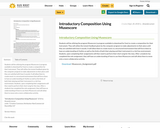
Students will be introduced to the basics of agriculture through exploring books.
- Subject:
- Agriculture Studies
- Material Type:
- Activity/Lab
- Lesson
- Provider:
- Iowa Agriculture Literacy Foundation
- Author:
- Kelsey Faivre
- Shari Davis
- Date Added:
- 10/11/2018

Students will be introduced to the basics of agriculture through exploring books.

Students are introduced to Old English and the poetic devices of alliteration, kenning, and compounding in preparation for reading the epic poem "Beowulf".

Students explore the basics of DC circuits, analyzing the light from light bulbs when connected in series and parallel circuits. Ohm's law and the equation for power dissipated by a circuit are the two primary equations used to explore circuits connected in series and parallel. Students measure and see the effect of power dissipation from the light bulbs. Kirchhoff's voltage law is used to show how two resistor elements add in series, while Kirchhoff's current law is used to explain how two resistor elements add when in parallel. Students also learn how electrical engineers apply this knowledge to solve problems. Power dissipation is particularly important with the introduction of LED bulbs and claims of energy efficiency, and understanding how power dissipation is calculated helps when evaluating these types of claims. This activity is designed to introduce students to the concepts needed to understand how circuits can be reduced algebraically.

This 11-minute video lesson introduces conic sections.

Students are introduced to the concept of simple tools and how they can make difficult or impossible tasks easier. They begin by investigating the properties of inclined planes and how implementing them can reduce the force necessary to lift objects off the ground.

This week, Stan Muller launches the Crash Course Intellectual Property mini-series. So, what is intellectual property, and why are we teaching it? Well, intellectual property is about ideas and their ownership, and it's basically about the rights of creators to make money from their work. Intellectual property is so pervasive in today's world, we thought you ought to know a little bit about it. We're going to discuss the three major elements of IP: Copyright, Patents, and Trademarks.

This resource is an introduction to William ShakespeareŐs tragic play, "The Tragedy of Julius Caesar", through the study of universal themes using multiple-perspective investigations of betrayal scenarios.

This task lets students explore the differences between linear and non-linear functions. By contrasting the two, it reinforces properties of linear functions. The task lends itself to an extended discussion comparing the differences that students have found and relating them back to the equation and the graph of the two functions.

Students will develop basic skills in programming by using loops, control structures, and variables. Students will use the Tynker platform.

This video provides and introduction to the Four Seasons of Reconciliation program.
"4 Seasons of Reconciliation is a unique 3-hour online course that promotes a renewed relationship between Indigenous Peoples and Canadians through transformative learning about truth and reconciliation."
Sun West Teachers - to register for the course email dlchelp@sunwestsd.ca

The purpose of this lesson is to show learners how to keep a nature journal. How to reflect, respond, and question the observations they see in the world.

Students will be utilizing the program Musescore (a program available to download for free) to
create a composition for their instrument. They will utilize the instant feedback given by the computer program to make adjustments to their piece until they are satisfied with how it sounds. It will allow them to create music in a structured environment that will force them to have an understanding of rhythm as well as the limits of both their playing and their instrument in a risk free environment. Students, upon completing their assignments will then need to perform their short song for the class. After a students has completed the solo assignment, they will have an understanding of how to use them Musescore and will allow them to move onto a more collaborative activity.

Algorithms are the sets of steps necessary to complete computation - they are at the heart of what our devices actually do. And this isn’t a new concept. Since the development of math itself algorithms have been needed to help us complete tasks more efficiently, but today we’re going to take a look a couple modern computing problems like sorting and graph search, and show how we’ve made them more efficient so you can more easily find cheap airfare or map directions to Winterfell... or like a restaurant or something.

Today, we're going to begin our discussion of Big Data. Everything from which videos we click (and how long we watch them) on YouTube to our likes on Facebook say a lot about us - and increasingly more and more sophisticated algorithms are being designed to learn about us from our clicks and not-clicks. Today we're going to focus on some ways Big Data impacts on our lives from what liking Hello Kitty says about us to how Netflix chooses just the right thumbnail to encourage us to watch more content. And Big Data is necessarily a good thing, next week we're going to discuss some of the problems that rise from collecting all that data.

Students are introduced to the basic principles behind engineering and the types of engineering while learning about a popular topic - the Olympics. The involvement of engineering in modern sports is amazing and pervasive. Students learn about the techniques of engineering problem solving, including brainstorming and the engineering design process. The importance of thinking out of the box is stressed through a discussion of the engineering required to build grand, often complex, Olympic event centers. Students review what they know about kinetic and potential energy as they investigate the design of energy-absorbing materials, relating this to the design of lighter, faster and stronger sporting equipment to improve athletic performance and protect athletes. Students consider states of matter and material properties as they see the role of chemical engineering in the Olympics. Students also learn about transportation and the environment, the relationship between architecture and environment, and the relationship between architecture and engineering.

We've been asking big questions for a really long time and we've all wanted to explore how we've sought to answer those questions through the centuries. Questions like, "What is stuff?" and "Where are we?" have inspired people all over the world to investigate. So lets dive in and see how we, as a people, have tried to figure this stuff out in this first episode of Crash Course History of Science!

Introduce students to biodiesel, ethanol, and biomass in terms of agricultural and societal importance, while strengthening students’ research and technical writing skills.

La plateforme d’Intuit vous aide à avoir une plus grande confiance financière grâce à TurboImpôt, Credit Karma, QuickBooks et Mailchimp. Une personne et une communauté à la fois.
Logiciel Intuit gratuit pour les éducateurs et les étudiants. Que vous souhaitiez enseigner ou devenir comptable, aide-comptable ou entrepreneur, vous serez prêt avec les produits Intuit.
Enseignement flexible
Logiciel gratuit
Accès aux ressources

This site gives the background and information about a number of Inuit Games.

This multi-disciplinary resource features ten engaging lessons that focus on biodiversity and invasive species. An ecosystem approach provides an authentic context to help students understand what invasive species are and how these plants and animals can significantly impact the vital interdependence of organisms within habitats. Although developed to support the Grade 6 Life Sciences curriculum (Ontario), the strong English Language Arts, Math and Social Studies links make this resource applicable across a broad range of subject areas and grade levels.
In a combination of in-class and outdoor activities students will:
- Define and explore types of invasive species.
- Identify how organisms interact within ecosystems.
- Respond to media information about invasive species.
- Explore a local habitat to find and catalogue native and non-native species.
- Initiate action to inform the community about the prevention of the spread of invasive species.